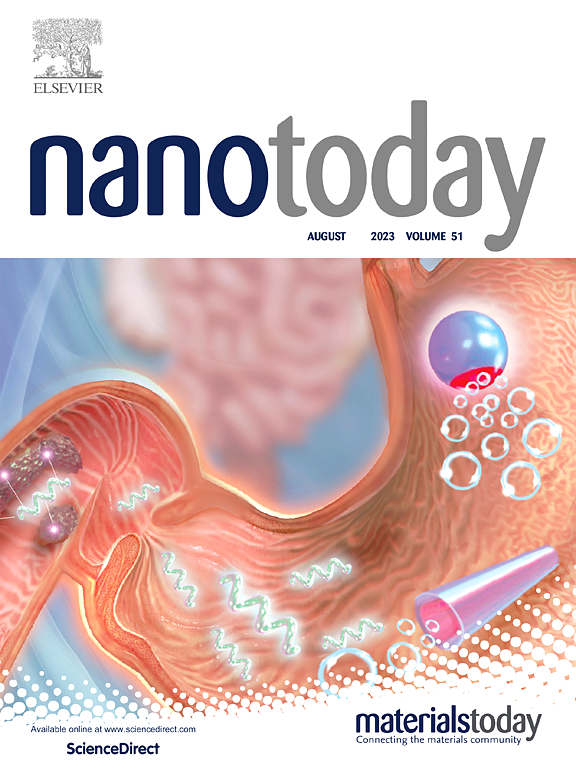多巴胺进化的中空介孔纳米球锚定Mn-Cu双单原子用于NIR-II增强催化治疗
IF 10.9
1区 材料科学
Q1 CHEMISTRY, MULTIDISCIPLINARY
引用次数: 0
摘要
单原子纳米酶(SAzymes)已成为肿瘤催化治疗的有希望的候选者。然而,单一催化位点管理多个催化反应和中间体的挑战限制了催化活性的进一步提高。在此,我们设计并合成了一种自我增强的纳米催化剂(CaO2@P-DAzyme),将双金属活性位点嵌入到n掺杂的中空介孔碳球上,负载CaO2并用聚乙二醇修饰,以实现内在的三酶样(过氧化物酶、过氧化氢酶和氧化酶)活性,用于肿瘤催化治疗。密度泛函理论计算表明锰原子周围的电子密度增加,由于铜的引入,传授与最小CaO2@P-DAzyme过氧化氢吸附能量(-0.118 eV),导致更高的Vmax(2.37 7 M s×10−−1)和较低的公里(2.57 毫米)相比SAzyme-Cu (Vmax = 1.45 7 M s×10−−1公里= 6.57 毫米)和SAzyme-Mn (Vmax = 1.82 7 M s×10−−1公里= 4.46 毫米)。此外,中空介孔结构增强了活性位点的暴露,提高了H2O2和O2的吸附,并允许CaO2负载,促进H2O2的自补充和缺氧缓解,进一步放大了CaO2@P-DAzyme的三重酶样活性。此外,CaO2@P-DAzyme的高光热转换效率(51.95 %)在近红外ii区(NIR-II)窗口诱导光热治疗(PTT),以提高双金属活性位点的催化效率。总体而言,CaO2@P-DAzyme代表了nir - ii触发和自我强化ptt催化治疗的有希望的方法,为设计具有增强催化活性的多种SAzymes用于癌症治疗提供了可行的策略。本文章由计算机程序翻译,如有差异,请以英文原文为准。
Dopamine-evolved hollow mesoporous nanospheres anchoring Mn-Cu dual single-atoms for NIR-II reinforced catalytic therapy
Single-atom nanozymes (SAzymes) have emerged as promising candidates for tumor catalytic therapy. However, the challenge of a single catalytic site managing multiple catalytic reactions and intermediates restricts further enhancement of catalytic activity. Herein, we designed and synthesized a self-reinforcing nanocatalyst (termed CaO2@P-DAzyme), featuring dual metal active sites embedded on N-doped hollow mesoporous carbon spheres, loaded with CaO2 and modified with polyethylene glycol, to achieve intrinsic triple enzyme-like (peroxidase, catalase, and oxidase) activity for tumor catalytic therapy. Density functional theory calculations revealed that the increased electron density around the Mn atom, attributed to the introduction of Cu, imparts CaO2@P-DAzyme with a minimal H2O2 adsorption energy (-0.118 eV), resulting in a higher Vmax (2.37 × 10−7 M s−1) and lower Km (2.57 mM) compared to SAzyme-Cu (Vmax = 1.45 × 10−7 M s−1, Km = 6.57 mM) and SAzyme-Mn (Vmax = 1.82 ×10−7 M s−1, Km = 4.46 mM). Additionally, the hollow mesoporous structure enhances the exposure of active sites, improves H2O2 and O2 adsorption, and allows CaO2 loading to facilitate H2O2 self-supplementation and hypoxia relief, further amplifying the triple enzyme-like activities of CaO2@P-DAzyme. Moreover, the high photothermal conversion efficiency (51.95 %) of CaO2@P-DAzyme in the near-infrared-II region (NIR-II) window induced photothermal therapy (PTT) to augment the catalytic efficiency of the dual metal active sites. Overall, CaO2@P-DAzyme represents a promising approach for NIR-II-triggered and self-reinforcing PTT-catalytic therapy, offering a viable strategy for designing diverse SAzymes with enhanced catalytic activities for cancer therapy.
求助全文
通过发布文献求助,成功后即可免费获取论文全文。
去求助
来源期刊

Nano Today
工程技术-材料科学:综合
CiteScore
21.50
自引率
3.40%
发文量
305
审稿时长
40 days
期刊介绍:
Nano Today is a journal dedicated to publishing influential and innovative work in the field of nanoscience and technology. It covers a wide range of subject areas including biomaterials, materials chemistry, materials science, chemistry, bioengineering, biochemistry, genetics and molecular biology, engineering, and nanotechnology. The journal considers articles that inform readers about the latest research, breakthroughs, and topical issues in these fields. It provides comprehensive coverage through a mixture of peer-reviewed articles, research news, and information on key developments. Nano Today is abstracted and indexed in Science Citation Index, Ei Compendex, Embase, Scopus, and INSPEC.
 求助内容:
求助内容: 应助结果提醒方式:
应助结果提醒方式:


